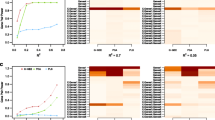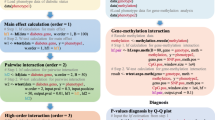Abstract
Arising from G. Hemani et al. Nature 508, 249–253 (2014); doi:10.1038/nature1300510.1038/nature13005
Epistasis occurs when the effect of a genetic variant on a trait is dependent on genotypes of other variants elsewhere in the genome. Hemani et al. recently reported the detection and replication of many instances of epistasis between pairs of variants influencing gene expression levels in humans1. Using whole-genome sequencing data from 450 individuals we strongly replicated many of the reported interactions but, in each case, a single third variant captured by our sequencing data could explain all of the apparent epistasis. Our results provide an alternative explanation for the apparent epistasis observed for gene expression in humans. There is a Reply to this Brief Communication Arising by Hemani, G. et al. Nature 514, http://dx.doi.org/10.1038/nature13692 (2014).

Similar content being viewed by others
References
Hemani, G. et al. Detection and replication of epistasis influencing transcription in humans. Nature 508, 249–253 (2014)
Wood, A. R. et al. Allelic heterogeneity and more detailed analyses of known loci explain additional phenotypic variation and reveal complex patterns of association. Hum. Mol. Genet. 20, 4082–4092 (2011)
Hemani, G., Theocharidis, A., Wei, W. & Haley, C. EpiGPU: exhaustive pairwise epistasis scans parallelized on consumer level graphics cards. Bioinformatics 27, 1462–1465 (2011)
Nielsen, D. M., Ehm, M. G., Zaykin, D. V. & Weir, B. S. Effect of two- and three-locus linkage disequilibrium on the power to detect marker/phenotype associations. Genetics 168, 1029–1040 (2004)
DePristo, M. A. et al. A framework for variation discovery and genotyping using next-generation DNA sequencing data. Nature Genet. 43, 491–498 (2011)
Browning, B. L. & Yu, Z. Simultaneous genotype calling and haplotype phasing improves genotype accuracy and reduces false-positive associations for genome-wide association studies. Am. J. Hum. Genet. 85, 847–861 (2009)
Li, Y., Willer, C. J., Ding, J., Scheet, P. & Abecasis, G. R. MaCH: using sequence and genotype data to estimate haplotypes and unobserved genotypes. Genet. Epidemiol. 34, 816–834 (2010)
Barrett, J. C., Fry, B., Maller, J. & Daly, M. J. Haploview: analysis and visualization of LD and haplotype maps. Bioinformatics 21, 263–265 (2005)
Author information
Authors and Affiliations
Contributions
A.R.W., T.M.F. and M.N.W. designed the study. A.R.W., M.A.T. and M.N.W. performed the bioinformatics analyses. M.A.N., D.G.H., S.B., A.B.S., D.M. and L.F. provided the Inchianti study and expression data. A.R.W., T.M.F. and M.N.W. wrote the manuscript. All authors commented on the manuscript.
Corresponding authors
Ethics declarations
Competing interests
Competing Financial Interests Declared none.
PowerPoint slides
Rights and permissions
About this article
Cite this article
Wood, A., Tuke, M., Nalls, M. et al. Another explanation for apparent epistasis. Nature 514, E3–E5 (2014). https://doi.org/10.1038/nature13691
Received:
Accepted:
Published:
Issue Date:
DOI: https://doi.org/10.1038/nature13691
- Springer Nature Limited
This article is cited by
-
An approach to identify gene-environment interactions and reveal new biological insight in complex traits
Nature Communications (2024)
-
Fast kernel-based association testing of non-linear genetic effects for biobank-scale data
Nature Communications (2023)
-
Missing Causality and Heritability of Autoimmune Hepatitis
Digestive Diseases and Sciences (2023)
-
Whole genome sequencing reveals epistasis effects within RET for Hirschsprung disease
Scientific Reports (2022)
-
Phantom epistasis between unlinked loci
Nature (2021)





